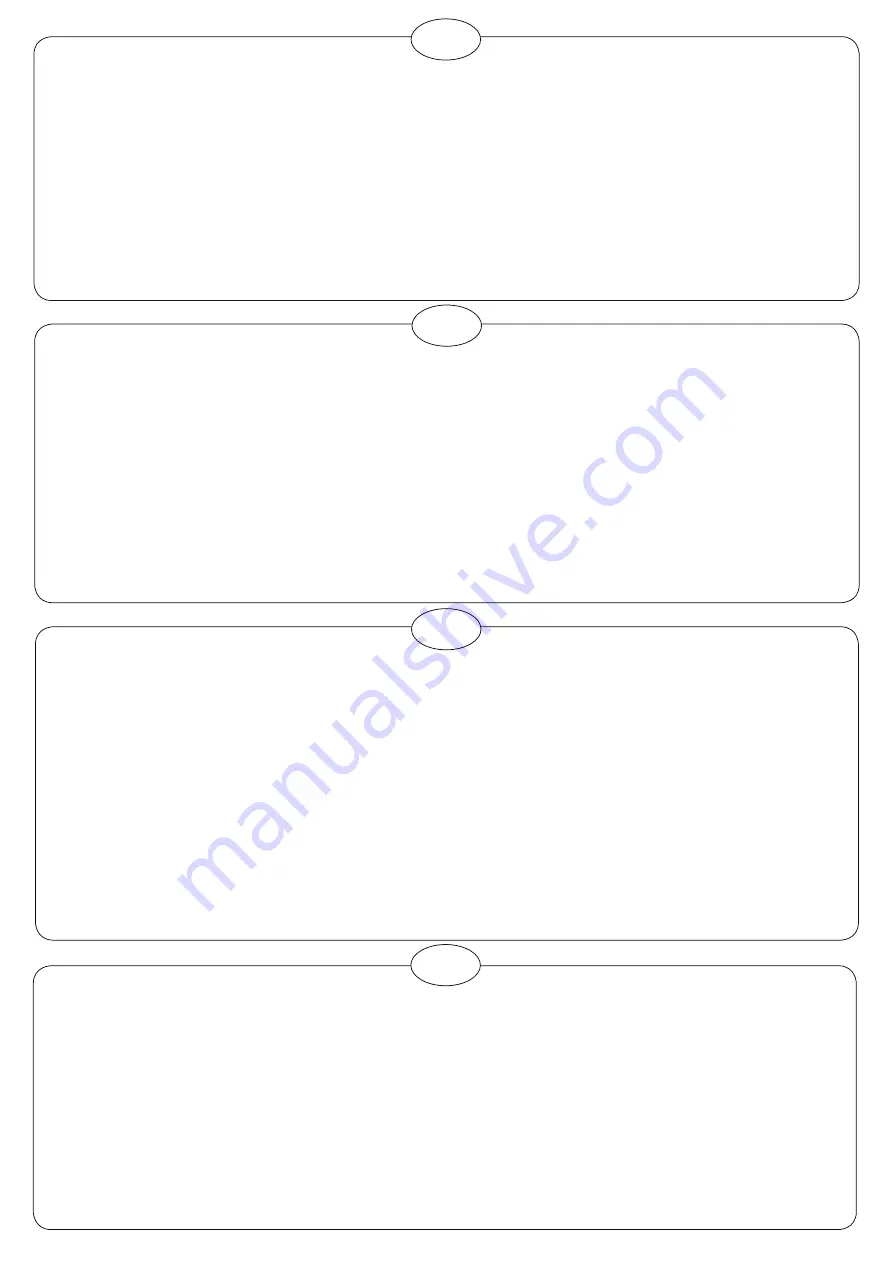
General Instructions
Raychem tubing is supplied in an expanded form. When heated above 125°C they attempt to shrink back to their original dimensions,
conforming to the objects they cover. Use a propane (preferred) or butane gas torch.
Adjust the torch to obtain a soft blue ame with a yellow tip. Pencil-like blue ames should be avoided. Keep the torch aimed in the shrink
direction to preheat the material. Keep the ame moving continuously to avoid scorching the material. Tubing should be cut smoothly with a
sharp knife leaving no jagged edges. Clean and degrease cable and parts that will come into contact with the tubing. When installing multiple
tubing make sure that the surface of the last tube is still warm before positioning and shrinking the next tube. If installed tube has cooled, reheat
the entire surface.
Thin wall tubing
(wall thickness up to 1 mm): Use a hot air gun and follow the General Instructions as appropriate.
Industrial scale production using uncoated tubing
:
It is recommended to use a forced circulation hot air oven.
1.
Vertical installation
: Place tubing over the relevant area. Start shrinking at the lower end working towards the top.
2.
Horizontal installation
: Place tubing over the relevant area. Start shrinking in the centre working towards the ends.
3. Properly installed tubing should be smooth and conform to the inner components. On coated tubing adhesive should be visible at both
ends.
Note
: Allow to cool before applying mechanical strain.
Allgemeines
Raychem wärmeschrumpfende Schläuche werden in expandierter Form geliefert. Bei Erwärmung auf Temperaturen über 125°C schrumpfen
sie auf ihre vorbestimmte Größe (Herstellungszustand) und passen sich ganz der Form des darunterliegenden Körpers an. Beschichtete
Teile umschließen das zu schützende Bauteil fest– und feuchtigkeitsdicht, wobei Kleber bzw. Dichtungsmasse schmilzt und alle Riefen und
Hohlräume ausfüllt.
Montagehinweise
Möglichst Propan- (wird bevorzugt) oder Butangas verwenden. Weiche, gelbe Flammenspitze einstellen. Scharfe, blaue Flammenspitze
vermeiden. Flamme beim Aufschrumpfen in Schrumpfrichtung halten, damit Schläuche entsprechend vorgewärmt werden. Brenner stetig
bewegen, um örtliche Überhitzung zu vermeiden. Metallteile gut vorwärmen (ca. 60°C).
Sämtliche zu verklebenden Teile reinigen und mit fettfreiem Lösungsmittel entfetten. Gebrauchsanweisung des Lösungsmittelherstellers ist
zu beachten. Bei Verarbeitung von dünnwandigen Schrumpfschläuchen (Wanddicke bis 1 mm) wird ein Heißluftgebläse als Wärmequelle
empfohlen. Bei industrieller Serienanfertigung von unbeschichteten Schläuchen werden Warmluftöfen mit Luftumwälzung empfohlen.
1. Schläuche in senkrechter Lage vom unteren Ende ausgehend aufschrumpfen.
2. Schläuche in waagerechter Lage von der Mitte ausgehend aufschrumpfen. Lufteinschlüsse vermeiden. Bei unter-schiedlichen
Durchmessern des zu schützenden Bauteils, Schläuche von der größeren Seite ausgehend aufschrumpfen.
3. Schläuche müssen rundum fest und faltenfrei anliegen. Schläuche vor mechanischer Belastung auf Umgebungstemperatur abkühlen
lassen.
Algemene richtlijnen
Raychem krimpkousen worden in geëxpandeerde vorm geleverd. Wanneer ze boven 125°C verwarmd worden trachten ze terug te krimpen
naar hun originele vorm en sluiten aldus perfect aan over de vormen die ze bedekken.
Gebruik een propaan- (bij voorkeur) of een butaanbrander. Regel de brander zodanig dat U een zachte blauwe vlam met gele punt verkrijgt.
Houd de vlam in de krimprichting van de stukken teneinde ze voor te verwarmen.
De vlam moet voortdurend in beweging blijven zodat het materiaal niet verbrand wordt. De krimpkousen moeten recht afgesneden worden.
Reinig en ontvet de delen die in contact komen met de krimpkous.
Indien er krimpkousen boven elkaar geïnstalleerd worden moet de oppervlakte van de laatst gekrompen krimpkous warm zijn alvorens de
volgende te installeren. Indien ze reeds afgekoeld is moet de oppervlakte herverwarmd worden.
Dunwandige krimpkousen
(wanddiktes tot 1 mm): Gebruik een warmeluchtgenerator in plaats van een brander.
Industriële productie gebruik makend van krimpkousen zonder kleefstof:
Het is aangeraden een oven te gebruiken met warme luchtcirculatie.
1.
Verticale installatie
Plaats de krimpkous over de te bedekken zone. Krimp ze te beginnen aan de onderzijde naar de bovenzijde toe.
2.
Horizontale installatie
Plaats de krimpkous over de te bedekken zone. Krimp ze te beginnen bij het midden naar beide uiteinden toe.
3. De krimpkousen moeten na installatie glad en zonder plooien zijn. De vorm van de aldus bedekte delen moet duidelijk zichtbaar zijn. Indien
de krimpkous met lijm bekleed is moet deze zichtbaar zijn aan beide uiteinden.
Nota
: Laat de krimpkousen afkoelen alvorens mechanisch te belasten.
GB
DE
BE
Instructions générales
Les fourreaux Raychem sont livrés sous forme expansée. Quand ils sont chauffés au-delà de 125° C, ils se rétreignent pour retrouver leurs
dimensions originales, se conformant aux objets qu’ils recouvrent. Utilisez une torche alimentée en propane (de préférence) ou en butane.
Réglez la torche pour obtenir une amme douce avec une extrémité jaune et non ron ante. Orientez la torche dans la direction du rétreint a n
de préchauffer le matériau. Maintenez la amme en mouvement de façon permanente pour éviter d’endommager le matériau. Les fourreaux
doivent être coupés proprement avec un outil bien aiguisé. Nettoyez et dégraissez les parties qui seront en contact avec le fourreau. Lors de
l’installation de fourreaux superposés, véri ez que la surface du dernier fourreau est encore tiède avant de positionner et rétreindre le fourreau
suivant. Si ce n’était pas le cas, réchauffez la surface toute entière.
Fourreau à paroi mince (épaisseur de paroi inférieure à 1 mm). Utilisez un générateur à air chaud et suivez les instructions générales
appropriées.
Production en usine utilisant des fourreaux non enduits :
Il est fortement recommandé d’utiliser une étuve à circulation d’air chaud.
1.
Installation verticale :
positionnez le fourreau et commencez le rétreint par le bas en remontant progressivement.
2.
Installation horizontale :
positionnez le fourreau et commencez le rétreint par le milieu et en progressant vers les extrémités.
3. Un fourreau correctement installé doit être lisse, sans plis et se conformer au substrat. Si le fourreau est enduit d’adhésif, il doit être visible
aux deux extrémités.
Note : Laissez refroidir avant d’appliquer toute contrainte mécanique.
FR





















